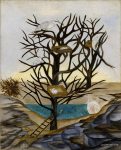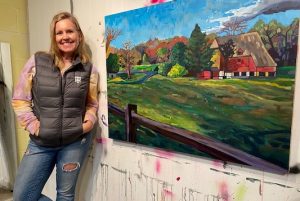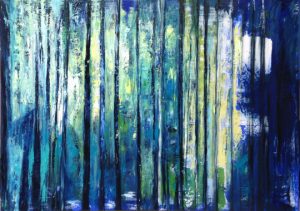What does it mean to be an artist? Is it the training, the talent, the schooling, the medium? The boundaries of art are constantly being redefined with artists themselves pushing the limits of what counts as art and the place it deserves in our world. Gatecrashers, the new exhibit at the Brandywine River Museum of Art, brings together two dozen artists who made a space for themselves in the art world in the early twentieth century.

“What I like about the term ‘Gatecrashers’ is that it emphasizes the agency of these artists,” says Katherine Jentleson, Curator of Folk and Self-Taught Art at the High Museum of Art in Atlanta, Georgia. She is the organizer of the exhibit and was on hand for the opening. “They weren’t just sitting around waiting to be discovered.”
Indeed, these artists exploded through boundaries after the First World War to carve out a place in the traditional art world. “There is courage to not only find the wherewithal to actually paint, but to enter their paintings in different kinds of display environments,” Jentleson says. “They don’t get enough credit for the kinds of choices they made and the confidence they developed in their abilities.”

Gatecrashers places the agency firmly back into the hands of the artists and their work. While so many of the included artists are now well-known, the exhibit explores their paths to the public consciousness. These artists not only broke with traditional art styles, heavily influenced by and imitating European works, they put their own spin on the form. No longer are they dismissed because of their lack of formal artistic schooling or professions. When a local newspaper announced in 1927, as John Kane was first accepted to the Carnegie International Exhibition, “Only Pittsburgher Admitted to International is a House Painter” in a dismissive tone and his work was called a prank, they did not foresee that he was paving the way for a new type of artist.
These types of exhibits are more than simply ways to visit beautiful artwork in person. They explore the role of art and where it exists in our world. Both in the early twentieth century and now, there have been those who question whether these artists should be shown alongside more “deserving” artists who had gone to the “right” schools and painted in traditional ways. This show “puts them back in the American story of art,” Jentleson notes.
The Brandywine River Museum is an especially poignant place for these pieces, as the show utilizes many of the Museum’s own artworks to create a conversation within the gallery. For example, Horace Pippin’s “Saying Prayers” and “The American Mother” by N.C. Wyeth, both from the Brandywine’s collection, have a special poignancy when seen as part of the wider movement. Paired, they create an emotional response that they might not otherwise induce.

There are also works on display from Anna Mary Robertson “Grandma” Moses, one of the most prominent gatecrashers of the art world. As the story goes, when she was discovered by Louis Caldor, a collector who saw her work in a drugstore window, he went to her home to ask how many paintings she had. Her daughter-in-law, the only one home at the time, told him there were ten. When Grandma Moses counted only nine, she cut one in half and reframed both to fill the order. Displayed side by side in this exhibit, “Shenandoah, South Branch” and “Shenandoah Valley (1861, News of the Battle)” display the cheeky ingenuity required by these artists.
Downstairs from Gatecrashers, in a new space which was specially modified for the exhibition, Night Coming Tenderly, Black is an exquisite display of ten works by photographer Dawoud Bey. The series imagines the flight of enslaved African Americans in the mid-nineteenth century as they pass through the Underground Railroad. The large silver gelatin prints were manipulated by Bey to appear as if they were taken in the dark of night, creating ethereal scenes. “Darkness was a way to cloak yourself,” says Audrey Lewis, Associate Curator at the Brandywine River Museum. The whole room is painted in a deep black paint and the lighting is carefully muted, creating a meditative experience that draws you in.
“It is about a sense of place,” Lewis notes. It is a familiar sense at the Brandywine, where “a lot of the artists, Andrew Wyeth in particular, their work creates a sense of place.” Walking through the other galleries in the museum emphasizes this point, where Wyeths and Pyles and so many other Brandywine Tradition artists showcase familiar vistas. “This is very different in every other way, but there is that feeling of the landscape that speaks to you,” says Lewis.

The gallery is ideal for immersing yourself in these photographs, which both draw you in to see detail and push you away to take them in as a whole. In a bigger space, the sensation might be lost. Here, the images reflect back and forth, enticing the viewer to turn again and again to each. Or instead, to take a moment to perch on the low stools in the center of the room and sit with the experience. Bey challenges the viewer to explore the secret history of the inspiration for these works, the travels of fugitive enslaved persons: “This mystery allowed me the conceptual space to reimagine what that movement might have been, how it might have looked and felt.”
Gatecrashers and Night Coming Tenderly, Black are exhilarating examples of what happens when you look beyond accepted standards. “They had something to say,” Jentleson says. “They didn’t necessarily call themselves artists, but they had something important to say, and they wanted the world to see it.” With these exhibitions, the audience is invited to hear, and see, and take notice.
Gatecrashers, curated by Katherine Jentleson and organized by the High Museum of Art, is on display the Brandywine River Museum of Art from May 28th through September 5th, 2022. Night Coming Tenderly, Black features photographs by Dawoud Bey from his acclaimed 2017 series. It is on view in the Brandywine’s Strawbridge Family Gallery from May 19th through August 31st, 2022. The Brandywine River Museum is located at 1 Hoffman’s Mill Road, Chadds Ford, PA. More information can be found online at Brandywine.org/Museum.
About Victoria Rose
Victoria Rose (she/her) is an editor, writer, avid reader, self-described geek, and fan of all things creative. Her passion for words has led to her current career as a freelance editor, and she is the owner of Flickering Words, an editing service. When not wielding a red pen (or cursor), she loves reading books of all genres, playing video, board, and word games, baking ridiculous creations to show off on the internet, or enjoying the gorgeous outdoors. She is a board member of the West Chester Film Festival and part of the Thirsty Monsters, a team of streamers from around the world who fundraise for various charities supporting LGBTQIA+ and accessibility rights. She can be found online @WordsFlickering or the Brandywine Art Guide @BrandywineArtGuide.
- Web |
- More Posts(113)





Comments